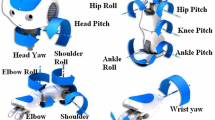Abstract
In this paper we deal with a remote meeting system with tangible interface, in which a robot is used as tangible avatar instead of a remote meeting partner. For realizing such system, it is a critical issue how the robot imitates human motions with natural and exact. So, we suggested a new method that human arm motion is captured with a stereo vision system and transferred to the robotic avatar with real-time. For capturing 3D arm motions based on markerless method, we proposed a new metaball-based method which was designed in order to have some robust and efficient properties: a modified iso-surface equation of metaball for overcoming local minima and a downsizing method of 3D point cloud for improving time complexity. With our meeting system, we have implemented our new algorithm and run at approximately 12–16 Hz. Also, its accuracy in motion capturing could be acceptable for robot motion generation.
Similar content being viewed by others
References
Park S (2002) Tangible space initiative (TSI). In: Tangible space initiative workshop in the 8th international conference on virtual systems and multimedia (VSMM2002), Gyengju, Korea, Sept. 25–27
Sminchisescu C, Kanaujia A, Li Z, Metaxas D (2005) Discriminative density propagation for 3D human motion estimation. Comput Soc Conf CVPR 1: 390–397
Agarwal A, Triggs B (2005) Monocular human motion capture with a mixture of regressors. In: IEEE international conference on computer vision, pp 123–130
Jojic N, Turk M, Huang TS (1999) Tracking self-occluding articulated objects in dense disparity maps. Comput Soc Conf CVPR 1: 390–397
Lin MH (1999) Tracking articulated objects in real-time range image sequences. In: IEEE international conference on computer vision, pp 648–653
Molina-Tanco L, Bandera JP, Marfil R, Sandoval R (2005) Real-time human motion analysis for human–robot interaction. In: IEEE/RSJ international conference on intelligent robots and systems, pp 1402–1407
Delamarre Q, Faugeras O (1999) 3D articulated models and multi-view tracking with silhouettes. IEEE Int Conf Comput Vis 2: 716–721
Deutscher J, Blake A, Reid I (2000) Articulated body motion capture by annealed particle filtering. IEEE Conf CVPR 2: 126–133
Cheung KM, Baker S, Hodgins JK, Kanade T (2004) Markerless human motion transfer. In: International symposium on 3D data processing, visualization and transmission, pp 374–378
Kim E-S, Kim JJ (2000) An automatic modeling method for fitting volumetric objects with metacubes. In: Eighth Pacific conference on computer graphics and applications, p 411
Plankers R, Fua P (2003) Articulated soft objects for multiview shape and motion capture. IEEE Trans Pattern Anal Mach Intell 25(9): 1182–1187
Kim JJ, Kim E-S, Park S-K (1997) An automatic description of volumetric objects using metaballs. In: Computer Graphics International, pp 65–73
Modeslund TB, Granum E (2001) HA survey of computer vision-based human motion capture. Comput Vis Image Underst 81: 231–268
Shi J, Tomasi C (1994) Good features to track. In: IEEE conference on computer vision and pattern recognition, pp 593–600
Tomasi C, Kanade T (1991) Detection and tracking of point features. Carnegie Mellon University Technical Report CMU- CS-91–132
Besl PJ, McKay ND (1992) A method for registration of 3-D Shapes. IEEE Trans Pattern Anal Mach Intell 14: 239–256
Covell M, Rahimi A, Harville M, Darrell T (2000) Articulated-pose estimation using brightness and depth-constancy constraints. Conf Comput Vis Pattern Recognit 2: 438–445
Riley M, Ude A, Wade K, Atkeson CG (2003) Enabling real-time full-body imitation: a natural way of transferring human movement to humanoids. In: IEEE international conference on robotics and automation, pp 2368–2374
Kim CH, Kim D, Oh Y (2005) Solving an inverse kinematics problem for a humanoid robots imitation of human motions using optimization. In: Second international conference on informatics in control, automation and robotics, pp 85–92
Murray RM, Li Z, Sastry SS (1993) A mathe-matical introduction to robotic manipulation. CRC Press, Boca Raton
Deluca-Cardillo D, Huynh DQ, Bennamoun M (2007) 3D pose recovery of the human arm from a single view. In: Procedding of image and vision computing New Zealand, pp 46–51
Knoop S, Vacekand S, Dillmann R (2006) Sensor fusion for 3D human body tracking with an articulated 3D body model. In: Conference on robotics and automation, pp 1686–1691
Author information
Authors and Affiliations
Corresponding author
Rights and permissions
About this article
Cite this article
Choi, Y., Ra, S., Kim, S. et al. Real-time arm motion imitation for human–robot tangible interface. Intel Serv Robotics 2, 61–69 (2009). https://doi.org/10.1007/s11370-009-0037-8
Received:
Accepted:
Published:
Issue Date:
DOI: https://doi.org/10.1007/s11370-009-0037-8




